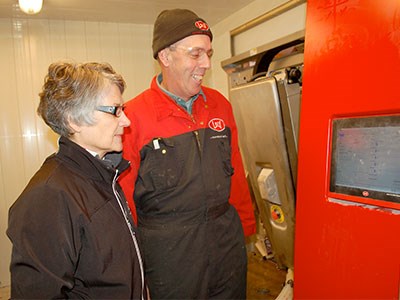The Haasen family had to consider some options when their main barn burned to the ground in November, 2011. One of them was to exit the dairy farm industry.
“That was on the table for five seconds,” said Frank Haasen, who along with his wife Ivy and son Eddy, manage the 500-acre property in Timmins.
“We could have rebuilt what we had before, or moved our 10-year business plan ahead to one year. We had been talking about (milking) robots so that is what we decided to do.”
About 20 cows from the herd of 90 were lost in the fire but so, too, did the life work of his father John, who bought the property in 1958 after emigrating from Holland.
“My dad, who will be 90, and just lives up the road from here, watched the fire that night,” Haasen said. “He built that all and it was going up in smoke, but he just said it was time for robots. He has always been forward thinking and willing to adopt new technology.”
The remaining herd was shipped to three farms in Earlton where they stayed for a year while the barn was rebuilt. Construction of the new facility began in June, 2012, and the two new robotic milking stations were ready for cows in early December, 2012.
The modern facility houses the most up-to-date commercially available robotic milking system currently available, designed by Lely, a Dutch multinational company.
“We had a relatively modern milking parlour that was well equipped,” he said. “We didn't go from poor to great but from a standard operation to a little more advanced technology. The robots are the key to it and the whole barn is designed around them to make them work as efficiently as possible.”
Getting used to the new technology was a learning process for both the cows and the Haasens. The manufacturer advised there would be “three days of hell and three weeks of tough sledding.”
“When we first started with the robots, we were out there 24 hours a day making sure they were all getting through,” said Ivy. “The transition went smoother than what we anticipated.”
The robots allow each cow to go through the milking station an average of three times a day. When they enter, the cow is identified and the appropriate amount of feed – referred to as cow candy by Haasen – is released. If they return too soon, the gate opens and they are not fed.
Brushes wash the udder and lasers locate the teats so the milking device can latch on. When the process is completed, a gate swings open and the cow walks out.
“No one is pushing them in or out, but at the beginning they had been led in,” Haasen said.
As of early December, only about a quarter of the herd had to be rounded up and “encouraged” to enter the station.
“The conventional way we did was to milk them twice a day so we got them into a holding area to do that,” he said. “Now, everything is on the cow's own time, 24 hours a day.”
A computer is checked three times a day to find which cows haven't been in the milking station for a certain amount of time and they are led to the robot. Information such as the temperature and volume of milk is captured by sensors.
“The robot is working 24 hours a day, seven days a week. It doesn't stop for coffee or call in sick,” Haasen said. “It's also easier and less stressful for the cows.”
The new barn also comes with stalls that include a water-filled mattress for the cows covered with straw.
The Haasens, along with one full-time employee, were looking forward to the twice-monthly return of the milk truck.
“It will be nice to see it again,” he said. “It's also nice to get some cash flow.”




